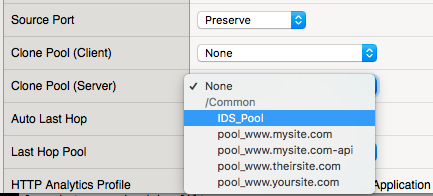F5 Firewall Solutions > Advanced Multi-Layer Firewall Protection > Module 1: F5 Multi-layer Firewall Source | Edit on
Lab 7: Configure A Clone Pool For SSL Visibility To IDS Sensors Or Other Security Tools¶
SSL encrypted traffic poses a problem for most security devices. The performance of those devices is significantly impacted when trying to decrypt SSL traffic. Since the BIG-IP is designed to handle SSL traffic with specialized hardware and optimized software libraries, it is in the unique position to ‘hand-off’ a copy of the decrypted traffic to other devices.
In this solution, since the BIG-IP is terminating SSL on the external virtual server, when we forward the traffic to the secondary virtual server in clear-text we have an opportunity to make an unencrypted copy of the application traffic and send it to an external sensor such as an IDS for further security assessment.
On BIG-IP
Inspect the preconfigured IDS_Pool.
Navigation: Local Traffic > Pools > Pool List >
Navigation Select the IDS_Pool
Navigation: Click on the Members Tab
Note
Unencrypted traffic will be forwarded to this IP address
Attach the IDS_Pool as a clone pool to the server side of the external virtual server
Navigation: Local Traffic > Virtual Servers > Virtual Server List > EXT_VIP_10_1_10_30.
Navigation: Select Advanced from the pulldown at the top of the Configuration section
Navigation: Scroll to the configuration for Clone Pool (Client) and select None
Navigation: Scroll to the configuration for Clone Pool (Server) and select IDS_pool
Navigation: Click on update at the bottom of the page.
Note
Leave all other fields using the default values.
Select the Putty application from the desktop on the jump host
Load Lamp Server from the sessions list
Open Lamp Server
Accept the certificate warning
login as f5
Attention
It will take about 30 seconds for the certificate login process- No password required
Input the TCPDUMP command to start capturing traffic
sudo tcpdump –i eth1 -c 200 port 8081
Initiate another attempt to connect to the website via curl using the Cygwin application on the desktop. Position windows on the desktop so that you can see both the Putty session and the Cygwin session
curl -k https://10.1.10.30:8081 -H 'Host:site1.com' -H 'X-Forwarded-For: 172.16.99.5'
curl -k https://10.1.10.30:8081 -H 'Host:site3.com' -H 'X-Forwarded-For: 172.16.99.5'
Initiate another attempt to connect to the websites using the browser
https://site2.com:8081
https://site4.com:8081
View the tcpdump output on the syslog-webserver.
Attention
It will take about 20 seconds after the transaction to appear in the tcpdump session. This is a performance problem on the lamp server
tcpdump: verbose output suppressed, use -v or -vv for full protocol decode
listening on eth2, link-type EN10MB (Ethernet), capture size 262144 bytes
17:25:42.585675 IP 10.10.99.222.50924 > 1.1.1.1.http: Flags [S], seq 912073522, win 4380, options [mss 1460,sackOK,eol], length 0
17:25:42.585905 IP 1.1.1.1.http > 10.10.99.222.50924: Flags [S.], seq 1263282834, ack 912073523, win 4380, options [mss 1460,sackOK,eol], length 0
17:25:42.585918 IP 10.10.99.222.50924 > 1.1.1.1.http: Flags [.], ack 1, win 4380, length 0
17:25:42.585926 IP 10.10.99.222.50924 > 1.1.1.1.http: Flags [P.], seq 1:79, ack 1, win 4380, length 78
17:25:42.586750 IP 1.1.1.1.http > 10.10.99.222.50924: Flags [.], ack 79, win 4458, length 0
17:25:42.673178 IP 1.1.1.1.http > 10.10.99.222.50924: Flags [P.], seq 1:252, ack 79, win 4458, length 251
17:25:42.673231 IP 10.10.99.222.50924 > 1.1.1.1.http: Flags [.], ack 252, win 4631, length 0
17:25:42.676360 IP 10.10.99.222.50924 > 1.1.1.1.http: Flags [F.], seq 79, ack 252, win 4631, length 0
17:25:42.676972 IP 1.1.1.1.http > 10.10.99.222.50924: Flags [.], ack 80, win 4458, length 0
17:25:42.688028 IP 1.1.1.1.http > 10.10.99.222.50924: Flags [F.], seq 252, ack 80, win 4458, length 0
17:25:42.688057 IP 10.10.99.222.50924 > 1.1.1.1.http: Flags [.], ack 253, win 4631, length 0
Note
Inspect the source and destination addresses. This traffic is cloned from the EXT_VIP
Note
This is the end of Module 1 - Lab 7.
